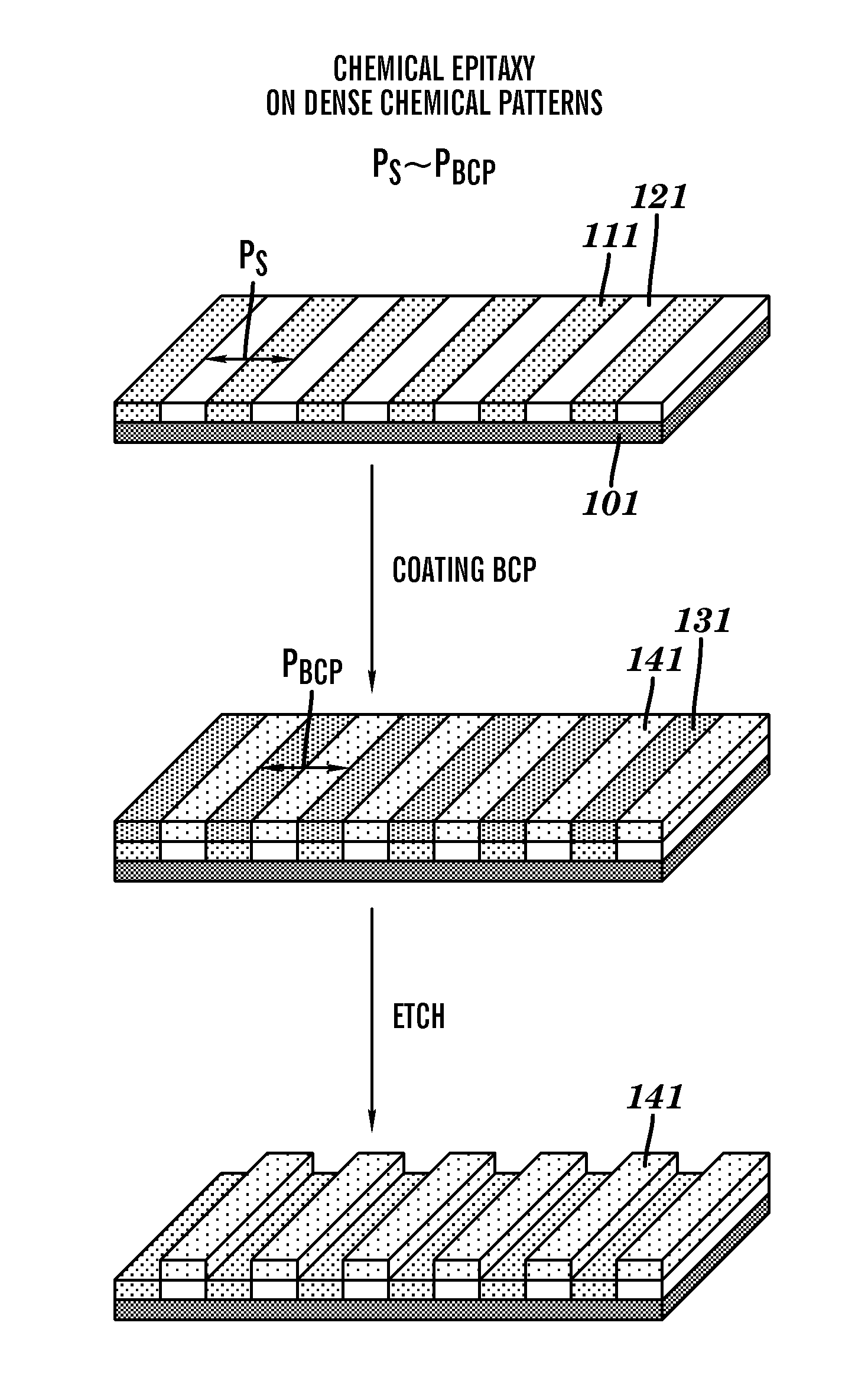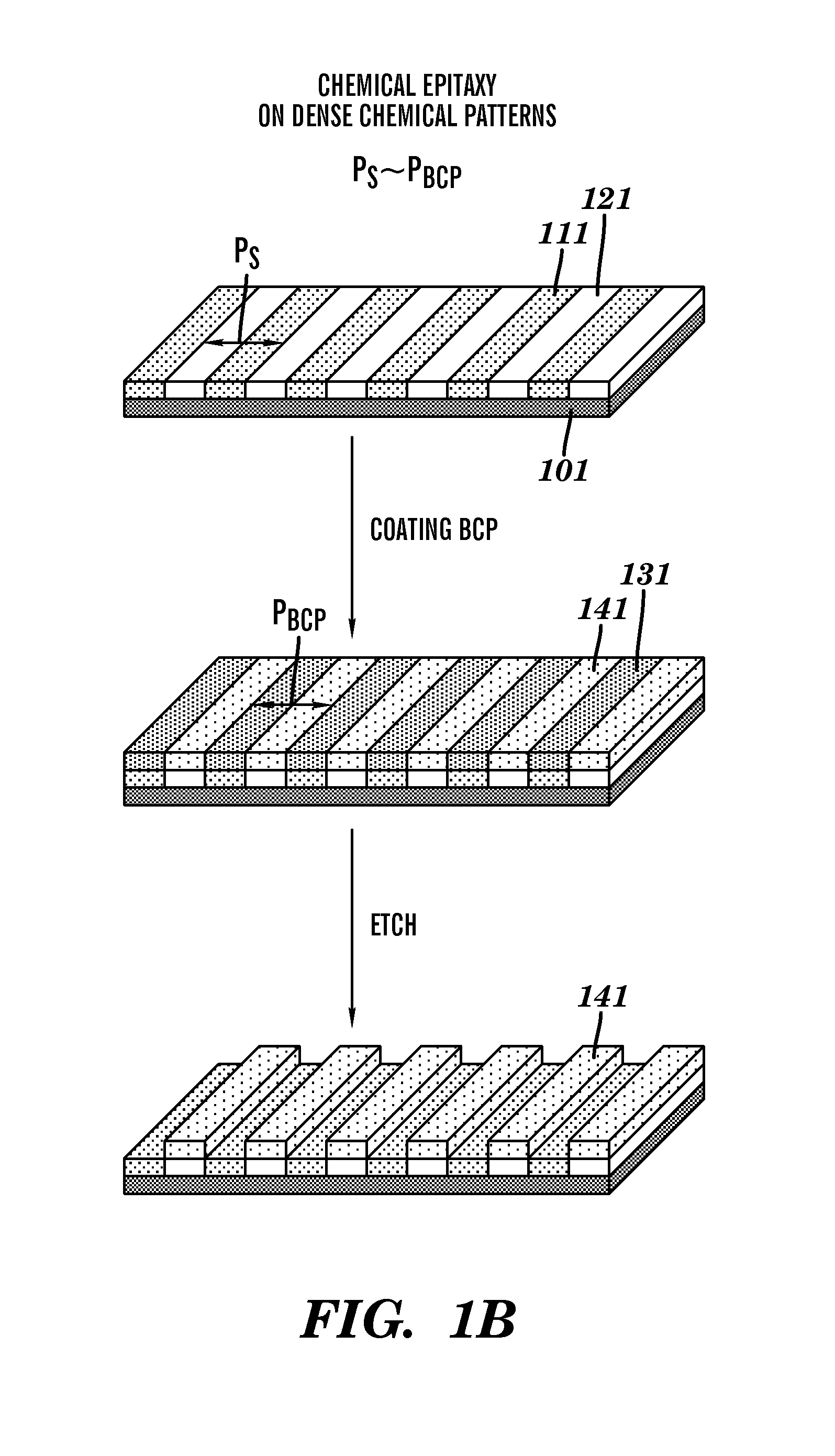Method of forming polymer features by directed self-assembly of block copolymers
a technology of polymer features and self-assembly, which is applied in the field of forming polymer features by directed self-assembly of block copolymers, can solve the problems of deterioration of placement accuracy and edge roughness of bcp domains during pattern formation, limited use of each of these methods in generating patterns with high resolution, and uneven pattern spacing across subdivided channels. , to achieve the effect of increasing device feature density, enhancing resolution of line spa
- Summary
- Abstract
- Description
- Claims
- Application Information
AI Technical Summary
Benefits of technology
Problems solved by technology
Method used
Image
Examples
example 1
[0077]A sparse chemical pattern was prepared by a two-layer method in which a thin coating of hydridosilsesquioxane (HSQ) was cast on the top surface of cross-linked poly(epoxydicyclopentadienyl methacrylate epoxide-ran-styrene) (30:70 molar ratio, respectively: also abbreviated as PEpoxyDCPMA30-r-PS70), on a silicon substrate. The PEpoxyDCPMA30-r-PS70 layer was crosslinked using N-hydroxyphthalimide triflate as a thermal acid generator (10 wt % based on the total weight of thermal acid generator and polymer) by baking at 130° C. for 1 minute and then at 200° C. for 2 minutes. The PEpoxyDCPMA30-r-PS70 provided a neutral surface for poly(styrene-b-methylmethacrylate) (abbreviated as “PS-b-PMMA”), and HSQ provided a preferentially wettable surface for PMMA. The HSQ layer was imaged by direct write electron beam lithography and developed using an 0.26N tetraethylammonium hydroxide (TMAH) developer to generate a pattern of thin stripes having a total pitch of 57.5 nm, HSQ line width of ...
example 2
[0078]A sparse chemical pattern was made by a two-layer process as described in Example 1, with the chemical pattern prepared from a thin coating of hydridosilsesquioxane (HSQ) formed on thermally cross-linked PEpoxyDCPMA30-r-PS70. The HSQ layer was imaged and developed as in Example 1 to generate thin stripes with a pitch of 87.5 nm, an HSQ line width of 20 nm and an HSQ line height of 2.5 nm (FIG. 4A). A 1.5 wt % solution of PS-b-PMMA in PGMEA was then cast on the sparse chemical patterns of HSQ / PEpoxyDCPMA-r-PS and baked at 240° C. for 1 minute. The polymer domains in the PS-b-PMMA film self-aligned on top of the sparse chemical pattern to form a frequency tripled pattern of alternating PS and PMMA stripes with pitch of about 28.2 nm (FIG. 4B).
example 3
[0079]A sparse chemical pattern was prepared by a two-layer method in which thin chromium (Cr) stripes were formed on the top surface of a thermally cross-linked organosilicate (OS) underlayer. The OS is a copolymer of methyltrimethoxysilane and tetraethoxysilane with a molecular weight Mw of 2,000 g / mol. The OS underlayer provides a neutral surface for the assembly of domains of the poly(styrene-b-ethylene oxide) (abbreviated PS-b-PEO, obtained from Polymer Source, with a molecular weight Mw for the PS block of 19,000 g / mol and for the PEO of 12,300 g / mol) cast along with a co-assembling OS component. The Cr surface serves as a preferentially wetted area for the PEO / OS domains. The sparse chemical pattern of thin Cr stripes having a pitch of 132 nm, a Cr linewidth of 20 nm, and a Cr line thickness of 2.5 nm was made by Cr deposition and liftoff of Cr from electron-beam patterned PMMA on the top surface of the OS underlayer. A 1% wt solution of PS-b-PEO and OS component (PS-b-PEO:OS...
PUM
| Property | Measurement | Unit |
|---|---|---|
| height | aaaaa | aaaaa |
| feature sizes | aaaaa | aaaaa |
| width | aaaaa | aaaaa |
Abstract
Description
Claims
Application Information
 Login to View More
Login to View More - R&D
- Intellectual Property
- Life Sciences
- Materials
- Tech Scout
- Unparalleled Data Quality
- Higher Quality Content
- 60% Fewer Hallucinations
Browse by: Latest US Patents, China's latest patents, Technical Efficacy Thesaurus, Application Domain, Technology Topic, Popular Technical Reports.
© 2025 PatSnap. All rights reserved.Legal|Privacy policy|Modern Slavery Act Transparency Statement|Sitemap|About US| Contact US: help@patsnap.com



